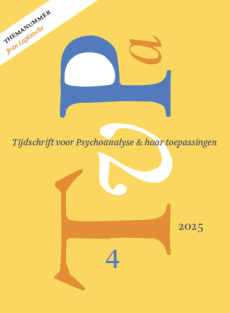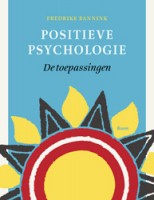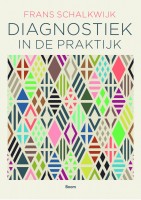Lichamelijkheid en affect bij psychosomatiek
Summary
Recent literature on affect is discussed from the point of view of its contribution to the understanding and treatment of psychosomatics. First, central theoretical tenets of one of the most important writers on psychosomatics, Joyce McDougall, are summarized. She emphasizes the importance of containment of primitive affective communication: carrying (‘dragen’) and giving sense (‘betekenis geven’) (Cluckers). How elaboration of ‘contained’ affective communication becomes possible, and the importance of this process in the building up of psychosomatic well-being of children, is shown from a developmental point of view; also the extent to which psychic elaboration remains difficult for children who react in a psychosomatic way. Stress is laid on the importance of investing the body (‘lichamelijkheid’) in affective communication, as a prerequisite for a meaningful verbal story about one’s self. It is especially difficult for psychosomatic patients to build up a living relationship to their own bodies and to work with the fantasizing power of the unconscious as well as to recognize the affects felt in the body and find words for these bodily feelings. Consideration is also given to the fact that, in psychosomatic states, the affectively experienced body and the spoken body no longer enrich each other. The importance of the French author André Green in connection with bodily experience, affect, language and psychosomatics is indicated.
Literatuur
- Alexander, F., T. French & G. Pollock (red.) (1968), Psychosomatic Specificity. The University of Chicago Press, Chicago/London.
- Aulagnier, P. (1975), La violence de l’interprétation. Presses Universitaires de France, Parijs.
- Binswanger, L. (1942), Grundformen und Erkenntnis menschlichen Daseins. Max Niehaus Verlag, Zürich.
- Bion, W. (1962a), Learning from Experience. Heinemann, London.
- Bion, W. (1962b), A Theory of Thinking. International Journal of Psycho-Analysis, 43, p. 306-310.
- Blum, H. (1991), Affect Theory and the Theory of Technique. In: T. Shapiro & R. Emde (red.), Affect: Psychoanalytic Perspectives. International Universities Press, Madison, p. 265-290.
- Chethik, M. (1989), Techniques of child therapy: psychodynamic strategies. Guilford Press, London.
- Cluckers, G. (1989), Containment in de therapeutische relatie: de therapeut als drager en zingever. In: H. Vertommen, G. Cluckers & G. Lietaer (red.), De relatie in therapie. Universitaire Pers, Leuven, p. 49-64.
- Cluckers, G., E. Gysen, S. Meykens e.a. (1982), Op weg met de therapeut. Een kennismaking met de psychodynamische kindertherapie. Van Loghum-Slaterus, Deventer.
- Cluckers, G., S. Meykens, M. Monthaye e.a. (1986), Steungevende kinderpsychotherapie: een andere weg. Van Loghum-Slaterus, Deventer.
- Cluckers, G. (red.) (1994), Andere therapeuten, andere wegen. Variaties op het thema IK-steun. Garant, Leuven/Apeldoorn.
- Coppolillo, H. (1990), Psychodynamic Psychotherapy of Children: an introduction to the art and the techniques. International Universities Press, Madison.
- Corveleyn, J. (1993), L’inconscient. In: J. Florence, A. Vergüte, J. Corveleyn e.a. (red.), Psychanalyse. L’homme et ses destins. Peeters, Leuven-Parijs, p. 133-190.
- Depestele, F. (1986), Het lichaam in psychotherapie. In: R. Van Balen, M. Leyssen & G. Lietaer (red.), Droom en werkelijkheid in de client-centered psychotherapie. Acco, Leuven-Amersfoort, p. 87-124.
- Depestele, F. (1995), Het lichaam voor de ‘gevoelde zin’. In: G. Lietaer & M. Van Kalmthout (red.), Praktijkboek Gesprekstherapie: Psychopathologie en experiëntiële procesbevordering. De Tijdstroom, Utrecht, p. 109-129.
- Devisch, R. (1985a), Approaches to Symbol and Symptom in Bodily Space-Time. International Journal of Psychology, 20, p. 389-415.
- Devisch, R. (1985b), Symbol and Psychosomatic Symptom in Bodily Space-Time. The case of the Yaka of Zaire. International Journal of Psychology, 20, p. 589-616.
- Devisch, R. (1989), Spiegel en bemiddelaar: de therapeut bij de Yaka van Zaïre. In: H. Vertommen, G. Cluckers & G. Lietaer (red.), De relatie in therapie. Universitaire Pers, Leuven, p. 331-357.
- Devisch, R. (1993), Soigner l’affect en remodelant le corps en milieu Yaka. Antropologie et Sociétés, 17, p. 215-237.
- De Vooght, L. (1994), ‘Atmosfeer’. In: P. Nijs (red.), De mens... in samenspraak... in tegenspraak. Peeters, Leuven, p. 105-118.
- Edgcumbe, R. (1984), Modes of Communication. The Differentiation of Somatic and Verbal Expression. Psychoanalytic Study of the Child, 39, p. 137-154.
- Emde, R. (1991), Positive Emotions for Psychoanalytic Theory: Surprises from Infancy Research and New Directions. In: T. Shapiro & R. Emde (red.), Affect: Psychoanalytic Perspectives. International Universities Press, Madison, p. 5-44.
- Enriquez, M. (1984), Aux Carrefours de la Haine. Epi/Desclée de Brouwer, Parijs.
- Fain, M. & P. Marty, (1964), Perspectives psychosomatiques sur la fonction des fantasmes. Revue française de Psychanalyse, 28, p. 609-622.
- Fédida, P. (1980), L’arrière-mère et le destin de la féminité. Psychanalyse à l’Université, 5, p. 195-212.
- Freud, S. (1905). Bruchstück einer Hysterié-analyse. Gesammelte Werke V, p. 163-268. Fischer Verlag, Frankfurt am Main, 1967
- Freud, S. (1915a), Die Verdrängung. Gesammelte Werke X, p. 249-261.
- Freud, S. (1915b), Triebe und Triebschicksale. Gesammelte Werke X, p. 211-232.
- Freud, S. (1916), Eine Beziehung zwischen einem Symbol und einem Symptom. Gesammelte Werke X, p. 394-395.
- Freud, S. (1924), Neurose und Psychose. Gesammelte Werke XIII, p. 387-391.
- Furman, E. (1992), On feeling and being felt with. Psychoanalytic Study of the Child, 47, p. 67-84.
- Gendlin, E. (1981), Focusing. Bantam Books, New York.
- Green, A. (1973), Le discours vivant. La conception psychanalytique de l’affect. Presses Universitaires de France, Parijs.
- Green, A. (1977), Theories of Affect. International Journal of Psycho-Analysis, 58, p. 129-156.
- Green, A. (1983), La mère morte. In: A. Green (red.), Narcissisme de vie, narcissisme de mort. Minuit, Parijs, p. 229-253.
- Green, A. (1984), Reflexions libres sur la representation de l’affect. Revue française de Psychanalyse, 49, p. 773-788.
- Groen, J. (1947), De psychopathogenese van het ulcus ventriculi et duodeni: karakterstructuren en emotioneele belevenissen en hun beteekenis voor aetiologie en therapie. Scheltema en Holkema, Amsterdam.
- Groen, J., J. Bastiaans & J. Van der Valk (1955), Syndroomverschuiving en onderdrukking en haar betekenis voor de interne en psychiatrische kliniek. Nederlands Tijdschrift voor Geneeskunde, 99, p. 1001-1008.
- Hammer, F.E. (1990), Reaching the Affect: Style in the Psychodynamic Therapies. Karnac Books, London.
- Jones, J.M. (1996), Affects as Process: An Inquiry into the Centrality of Affect in Psychological Life. Karnac Books, Londen.
- Jonghe, F. de, P. Rijnierse & R. Janssen (1992), The Role of Support in Psychoanalysis. Journal of the American Psychoanalytic Association, 40, p. 475-499.
- Kissen, M. (1995), Affect, Object and Character Structure. International Universities Press, Madison.
- Kreisler, L. (1992), Le nouvel enfant du desordre psychosomatique. Privat, Toulouse.
- Krystal, H. (1975), Affect Tolerance. Annual of Psychoanalysis, 3, p. 179-220.
- Krystal, H. (1982-1983), Alexithymia and the Effectiveness of psychoanalytic Treatment. International Journal of Psychoanalytic Psychotherapy, 9, p. 353-378.
- Lacan, J. (1977), Ecrits. Editions du Seuil, Parijs.
- Lamour, M. & S. Lebovici (1991), Les interactions du nourisson avec ses partenaires: évaluation et modes d’abord préventifs et thérapeutiques. Psychiatrie de l’enfant, 34, p. 171-275.
- Laplanche, J. & J. Pontalis (1973), Vocabulaire de la Psychanalyse. Presses Universitaires de France, Parijs.
- Mächtlinger, V. (1990), The Impact of some Early Developmental Disturbances on the Aims of Child and Adult Analysis: Symbolization and the Establishment of the Treatment Alliance. Bulletin of the Anna Freud Centre, 13, p. 85-102.
- Mahler, M., F. Pine & A. Bergman (1975), The Psychological Birth of the Human Infant: Symbiosis and Individuation. Hutchinson, Londen.
- Marcel, G. (1935), Etre et Avoir. Flammarion, Parijs.
- Marty, P. & M. de M’Uzan, M. (1963), ‘La Pensée opératoire’. Revue française de Psychanalyse, 27 bis, p. 345-356.
- McDougall, J. (1972), The anti-Analysand in Analysis. In: J. McDougall (red.), Ten Years of Psychoanalysis in France. International Universities Press, New York, p.36-50.
- McDougall, J. (1974), The Psychesoma and the Psychoanalytic Process. International Review of Psychoanalysis, 1, p. 437-459.
- McDougall, J. (1979), Primitive Communication and the Use of Countertransference. In: L. Epstein & A. Feiner (red.), Countertransference. Jason Aronson, New York, p. 267-303.
- McDougall, J. (1981), Corps et Métaphore. Nouvelle Revue de Psychanalyse française, 23, p. 53-81.
- McDougall, J. (1982), Theatres of the Mind: Illusion and Truth on the Psychoanalytic Stage. Basic Books, New York.
- McDougall, J. (1989), Theatres of the Body. A Psychoanalytic Approach to Psychosomatic Illness. Free Association Books, Londen.
- Meltzer, D. (1987), The Apprehension of Beauty. The Role of Aesthetic Conflict in Development, Violence and Art. The Clunie Press, Worchester.
- Merleau-Ponty, M. (1945), Phénoménologie de la Perception. Gallimard, Parijs.
- Meurs, P. (1988), Lichaam en Affect. Een ontwikkelingspsychologische en cultureel-antropologische benadering. Niet uitgegeven scriptie voor het postgraduaat in de Sociale en Culturele Antropologie onder leiding van Prof. Dr. R. Devisch, KU Leuven.
- Meurs, P. (1993), Betekenis van het concept ‘l’arrière-mère’ en het verband met communicatiebreuken bij een preoedipale stoornis. Een illustratie uit een psychodynamische kindertherapie. Tijdschrift Klinische Psychologie, 23, p. 1-22.
- Meurs, P. (1994), Lichamelijkheid en Psychosomatiek. Niet uitgegeven specialisatieverslag voor de postgraduaat opleiding in de psychodynamische kinderpsychotherapie onder leiding van Prof. Dr. G. Cluckers, KU Leuven.
- Moyaert, P. (1982a en b), Taal, lichamelijkheid en affect in de schizofrenie. Tijdschrift voor Psychiatrie, 24 (1) en 24 (11-12), p. 49-69 en p. 696-707.
- Monthaye, M. (1994), Lichaamswerk in psychotherapie: van structuur naar inhoud. In: G. Cluckers (red.), Andere therapeuten, andere wegen. Variaties op het thema IK-steun. Garant, Leuven/Apeldoorn, p. 103-126.
- M’Uzan, M. de (1974), Psychodynamic Mechanisms in Psychosomatic Symptomformation. Psychotherapy and Psychosomatics, 23, p. 203-210.
- Nemiah, J. & Sifneos, P. (1970), Affect and Fantasy in Patients with Psychosomatic Disorders. In: O. Hill (red.), Modern Trends in Psychosomatic Medecine. (Vol. 3). Butterworth, Londen, p. 430-439.
- Nijs, P. (1991), Man en Vrouw schiep Hij hen... Peeters, Leuven.
- Ogden, T. (1986), The Matrix of the Mind: Aspects of Object Relations Theory. Jason Aronson, New York.
- Ogden, T. (1992), The primitive Edge of Experience. Jason Aronson, New York.
- Paepe, L. & M. Robbroeckx (red.) (1994), Met heel mijn lijf. Lichamelijkheid tussen hebben en zijn. Altiora/KBS, Averbode/Den Bosch.
- Pierloot, R. (1956), Problèmes généraux de psychosomatique clinique. Nauwelaerts, Leuven.
- Plassmannn R. (1993), Organwelten: Grundriss einer analytischen Körperpsychologie. Psyche, 47, p. 261-282.
- Raes, H. (1995), Psychosomatiek. Psychoanalytische Perspektieven, 26, p. 9-26.
- Sami-Ali, M. (1980), Corps réel. Corps imaginaire. Dunod, Parijs.
- Sami-Ali, M. (1982), Penser le somatique. Nouvelle Revue de Psychanalyse française, 25, p. 299-308.
- Sami-Ali, M. (1984), Le visuel et le tactile: essai sur la psychose et l’allergie. Dunod, Parijs.
- Schotte, J. (1991), Onuitgegeven nota’s van de colleges Bijzondere Vraagstukken der Sexuele Psychopathologie, Familiale en Sexuologische Wetenschappen, K.U.Leuven (Academiejaar 1990-1991: Freud als psychopatholoog).
- Schur, M. (1955), Comments on the Metapsychology of Somatisation. Psychoanalytic Study of the Child, 10, p. 119-164.
- Shapiro, T. (1991), Words and Feelings in the Psychoanalytic Dialogue. In: T. Shapiro & R. Emde (red.), Affect: Psychoanalytic Perspectives. International Universities Press, Madison, p. 321-348.
- Sifneos, P. (1967), Clinical Observations on some Patients Suffering from a Variety of Psychosomatic Diseases. In: P. Sifneos (red.), Proceedings of the Seventh European Conference on Psychosomatic Research. S. Karger, Bazel, p. 171-187.
- Soenen, S. & R. Van Balen (1995), De genezende werking van het gesprek in psychotherapie. Een dialoog met E.T. Gendlin en J. Lacan. In: G. Lietaer & M. Van Kalmthout (red.), Praktijkboek Gesprekstherapie. Psychopathologie en experiëntiële procesbevordering. De Tijdstroom, Utrecht, p. 130-147.
- Speziale-Bagliacca, R. (1991), The capacity to contain: notes on its function in psychic change. International Journal of Psycho-Analysis, 72, p. 27-33.
- Stein, R. (1991), Psychoanalytic Theories of Affect. Praeger, New York.
- Stern, D. (1985), The Interpersonal World of the Infant. A View from Psychoanalysis and Developmental Psychology. Basic Books, New York.
- Stern, D. (1989), Developmental Prerequisites for the Sense of a Narrative Self. In: A. Cooper, O. Kernberg & E. Person (red.), Psychoanalysis: toward the second century. Yale University Press, New Haven-Londen, p. 168-180.
- Tellenbach, H. (1968), Geschmäck und Atmosphäre. Otto Müller, Salzburg.
- Vergote, A. (1966), De archeologische taal van het lichaam. In: W. Huber, H. Piron & A. Vergote, Psychoanalyse, wetenschap van de mens. De Nederlandsche Boekhandel, Antwerpen, p. 142-147.
- Vergote, A. (1981), Le Corps. In: L. Morren (red.), La Signification du Corps. De Boeck-Wesmael, Louvain-la-Neuve.
- Vergote, A. (1985), The Symbolic Body and the Symbolic Symptom. International Journal of Psychology, 20, p. 419-437.
- Vergote, A. (1989), De splitsing taai-lichaam in de schizofrenie. In: G. Kongs & H. De Cuyper (red.), Psychiatrie tussen mode en model: liber amicorum prof. Gerard Buyse. Peeters, Leuven, p. 193-211.
- Von Uexküll, T. (1991), Are functional syndromes culture-bound? In: B. Pfleiderer & G. Bibeau (red.), Anthropologies of Medicine. A Colloquium on West European and North American Perspectives. Vieweg, Braunschweig, p. 13-22.
- Winnicott, D. (1965), Ego Integration in Child Development. In: D. Winnicott (red.), The Maturational Processes and the Facilitating Environment. Hogarth Press, Londen, p. 56-63.
- Winnicott, D. (1970), The Mother-Infant Experience of Mutuality. In: J. Anthony & Th. Benedek (red.), Parenthood. Its Psychology and Psychopathology. Little, Brown and Company, Boston, p. 245-256.
 © 2009-2025 Uitgeverij Boom Amsterdam
© 2009-2025 Uitgeverij Boom Amsterdam
ISSN 1382-516x
De artikelen uit de (online)tijdschriften van Uitgeverij Boom zijn auteursrechtelijk beschermd. U kunt er natuurlijk uit citeren (voorzien van een bronvermelding) maar voor reproductie in welke vorm dan ook moet toestemming aan de uitgever worden gevraagd:
Behoudens de in of krachtens de Auteurswet van 1912 gestelde uitzonderingen mag niets uit deze uitgave worden verveelvoudigd, opgeslagen in een geautomatiseerd gegevensbestand, of openbaar gemaakt, in enige vorm of op enige wijze, hetzij elektronisch, mechanisch door fotokopieën, opnamen of enig andere manier, zonder voorafgaande schriftelijke toestemming van de uitgever.
Voor zover het maken van kopieën uit deze uitgave is toegestaan op grond van artikelen 16h t/m 16m Auteurswet 1912 jo. Besluit van 27 november 2002, Stb 575, dient men de daarvoor wettelijk verschuldigde vergoeding te voldoen aan de Stichting Reprorecht te Hoofddorp (postbus 3060, 2130 KB, www.reprorecht.nl) of contact op te nemen met de uitgever voor het treffen van een rechtstreekse regeling in de zin van art. 16l, vijfde lid, Auteurswet 1912.
Voor het overnemen van gedeelte(n) uit deze uitgave in bloemlezingen, readers en andere compilatiewerken (artikel 16, Auteurswet 1912) kan men zich wenden tot de Stichting PRO (Stichting Publicatie- en Reproductierechten, postbus 3060, 2130 KB Hoofddorp, www.cedar.nl/pro).
No part of this book may be reproduced in any way whatsoever without the written permission of the publisher.
Nieuwsbrief Boom Psychologie
Meld u nu aan en ontvang maandelijks de Boom Psychologie nieuwsbrief met aantrekkelijke aanbiedingen en de nieuwe uitgaven.
Aanmelden


